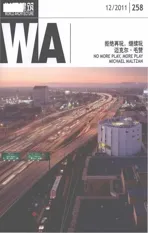现代艺术博物馆(皇后区),纽约,美国
2011-07-30司马蕾

1 屋顶夜景/Roof at night(摄影/Photo:Christian Richters)
1999年,现代艺术博物馆对其位于曼哈顿的设施进行了大规模的扩建,在扩建期间,博物馆花费3 500万美金将位于皇后区的Swingline订书机工厂改造成了临时展览场所——皇后区现代艺术博物馆(MoMA QNS)。
动态中的设施
MoMA QNS建成于2002年,规模14 307m2,在设计中有如下考虑。首先是博物馆与周边环境间的景观过渡。建筑形式处于城市和乡村的交界处——周边环境既不具有传统的市中心的特质,也不像一般的郊区景观。重要的是,这里的景观作为必要和基本的空间理所当然地存在于这里,形成城乡两种特质交换的场所。因为一直处于变化中,MoMA QNS的周边环境看上去并不成型,而是一直在流动。这种变动的环境为博物馆展示的当代文化、艺术和精神提供了重要背景。工厂原来的浅蓝色表皮在这不可辨识的环境中提供了强大的可识别性,因此不仅被保留下来,还得到了强化,形成一种既熟悉又陌生的效果。博物馆的外表与其尺度和规模一起,形成既具有讽刺性又具抽象感的特质,与周边环境异常丰富的多样性一起,构成复杂的视觉关系。
与材质相伴的形象
其次,这片郊区的场地上需要设计的不仅是即将改造的市中心的MoMA博物馆的一鳞半爪。相反,动态的特质应该是MoMA QNS的性格的一部分。在到达博物馆的途中,尤其在架空的7号轻轨线路上,列车从一栋大楼驶往车站的途中将有15秒时间路过这座建筑。在这个过程中,博物馆的新形象将逐步展现:它首先是一系列黑盒子般的屋顶上的抽象的形象,之后,这些形象糅合在一起形成了MoMA高识别度的标志性形象,最后,又再次溶解在环境中。
空间编排上的变化感
将博物馆的临时性特质融入它最重要的核心价值也是重要的设计要素之一。在传统的建筑或文化设计中,公共机构必须以会在社会中长期存在的形象示人。这种静态的公共性特质通常以公共大台阶的形式呈现。鉴于MoMA QNS具有更动感的特质,访客在进入博物馆前就进入参观动线中,并延伸至各展馆之间。这种顺序感让到达展馆时的感受得以加强,让MoMA QNS的入口不仅仅是跨越的边界线,而是由动态感受定义、并充满动感的空间的延伸。
虽然面临有限的预算和不明确的日程安排,MoMA QNS仍然在原本变化的周边环境中创造出独特的空间感受,让临时的博物馆能融入具有临时性和当代感的环境之中。□(司马蕾 译)

2 入口/Entrance(摄影/Photo:Christian Richters)

3 入口/Entrance(摄影/Photo:Christian Richters)

4 一层平面/First floor plan

5 夹层平面/Mezzanine plan
In 1999, the Museum of Modern art undertook a major expansion of its historic Manhattan facilities; in the interim a$35 million renovation of a Swingline Staples factory in Queens would become the Museum's home: MoMA QNS.
An Infrastructure of Movement
Completed in 2002, MoMA QNS’ 154,000 sf design can be seen as developing along three primary avenues of investigation. The first is an examination the museum's context within a transitional middle landscape, a condition between the urban and suburban which has neither the traditional identity of the urban center nor of the suburban landscape. Importantly, they exist,almost pathologically, as a necessary and essential zone: a place of exchange. In a constant state of becoming, MoMA QNS’ context is never fully formed but is instead in a permanent state of flux.This propelling condition constitutes an important context for contemporary culture, art, and understanding. As a result, the factory's original light blue color, which had a strong recognition value in an otherwise unremarkable context, was not simply maintained but was instead intensified,creating an amalgam at once familiar and unfamiliar. Coupled with the size and scale of the building, the Museum's presence, simultaneously iconic and abstract, could create a complex series of visual relationships within the context's overwhelming heterogeneity.
An Icon Engaged with Its Fabric
Second, the satellite site required the invention of an identity which was not a mere foreshadowing of the soon-to-be-remade midtown MoMA. Instead, the experience of movement came to constitute MoMA QNS’ identity. The journey to the Museum, primarily on the elevated No. 7 subway line, first engages the building above the street for a 15-second window as the train moves between an existing building and the station.Through this aperture the Museum's new identity appears: first as a series of abstract patterns across the rooftop's black boxes which then combine to form a legible reading of the MoMA logo before dissolving again.

6 从铁路看远景/Distant view from the front rail(摄影/Photo:Christian Richters)
Choreographing Change
Of critical significance was the transformation of the Museum's temporary nature into its most important asset. In a traditional architectural or cultural practice, to represent an institution is to assert their permanence within society. This static public identity, typically fixed in the form of a grand public stair, gives way to MoMA QNS' more dynamic identity, created by an extended procession which begins even before visitors arrive and continues through each of the Museum's galleries. This sequence extends the moment of arrival, rendering MoMA QNS' entry threshold not simply as a line to cross over, but instead as an expanded space of experience occupied and defined through movement.
Facing the challenges of a modest budget and an ambitious and inviolate schedule, MoMA QNS creates an extended choreography in what is otherwise a transitional zone, where the temporary is re-situated within a temporal, contemporary context.□
类型/Type:临时美术馆,剧场,咖啡店/Contemporary art museum, theater, & cafe
面积/Size: 14 307m2/154 000 sf
造价/Cost: $35 M
状态/Status: 2002年建成/Completed 2002

7 内景/Interior view(摄影/Photo:Christian Richters)

8 内景/Interior view(摄影/Photo:Christian Richters)
